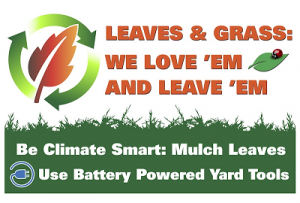Leaf Mulching 2020
Posted on: October 7, 2020 - 11:54am
For more info: leleny.org
Mulching-in-Place Is Not Some New Fad

Shredding your leaves where they are on the lawn, using shredded leaves as a winter mulch on landscape beds, collecting shredded leaves into compost piles, or simply leaving your leaves under the trees in wooded areas are all examples of using Mother Nature's own time-tested method of turning old leaves into new soil.
Benefits of Mulching-in-Place
Whether you "Do-It-Yourself" or hire a landscaper, LELE provides a number of benefits for your property:
- You'll have a greener lawn because as leaf mulch breaks down it naturally fertilizes the soil.
- You'll have a healthier lawn because leaf mulch improves soil structure and soil biology.
- It also helps improve drainage and water retention.
- "Free" mulch protects and enhances your landscape beds.
- Grass-cycling provides similar benefits for lawn fertilization and soil health.
There are also neighborhood- and community-wide environmental and cost benefits of LELE:
- Fewer vehicle trips to pick up and dispose of fall leaves, so it's better environmentally in terms of less air pollution and fewer gallons of fuel use.
- Quieter, because leaf blowers typically need to be used less.
- Safer, because fewer leaf piles spill over onto neighborhood sidewalks and roads.
- Helps protect water quality in our streams, lakes, and rivers by keeping decomposing leaves out of storm sewers.
- Labor, time, and materials savings at both the municipal and the county level can help reduce operating budgets (and thus provide tax relief).
Numbers, Numbers, Numbers - Did you know?
10:1 – That’s the reduction of volume of leaves you achieve when you mulch them with a mower or use a leaf shredder.
60.000 – The amount of tons of leaves handled in Westchester County every fall (Oct. —Dec.) and which could potentially be eliminated as handling waste [Estimates supplied by the Westchester County DEF (Department of Environmental Facilities) based upon metrics gathered in 2010].
$100,000-$750,000 – The estimated savings for specific municipalities from the reduction in County yard waste tipping fees, labor overtime, fuel, and transportation costs, specialized equipment purchase and maintenance, prevention of storm drain clogging, etc.
0 – The number of trips you have to make to the curb to place your bags or blow your leaves if you mulch-in-place.
60.000 – The amount of tons of leaves handled in Westchester County every fall (Oct. —Dec.) and which could potentially be eliminated as handling waste [Estimates supplied by the Westchester County DEF (Department of Environmental Facilities) based upon metrics gathered in 2010].
$100,000-$750,000 – The estimated savings for specific municipalities from the reduction in County yard waste tipping fees, labor overtime, fuel, and transportation costs, specialized equipment purchase and maintenance, prevention of storm drain clogging, etc.
0 – The number of trips you have to make to the curb to place your bags or blow your leaves if you mulch-in-place.

